
Roger William Corman was an American film director, producer, and actor. Known under various monikers such as "The Pope of Pop Cinema", "The Spiritual Godfather of the New Hollywood", and "The King of Cult", he was known as a trailblazer in the world of independent film.
American International Pictures LLC is an American film production company owned by Amazon MGM Studios. In its original operating period, AIP was an independent film production and distribution company known for producing and releasing films from 1955 until 1980, a year after its acquisition by Filmways in 1979.

Attack of the Giant Leeches is an independently made, 1959 black-and-white science fiction-horror film, produced by Gene Corman and directed by Bernard L. Kowalski. It stars Ken Clark, Yvette Vickers, Bruno VeSota and Jan Shepard. The screenplay was written by Leo Gordon. The film was released by American International Pictures on a double bill with A Bucket of Blood. Later, in some areas in 1960, Leeches played on a double bill with the Roger Corman film House of Usher.
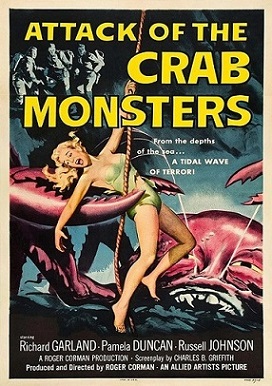
Attack of the Crab Monsters is a 1957 independently made American black-and-white science fiction-horror film, produced and directed by Roger Corman, that stars Richard Garland, Pamela Duncan, and Russell Johnson. The film was distributed by Allied Artists as a double feature showing with Corman's Not of This Earth.
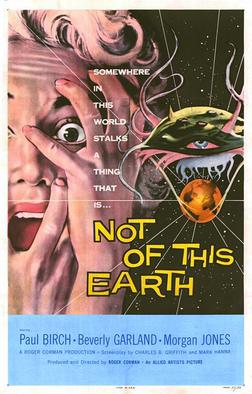
Not of This Earth is an independently made 1957 American black-and-white science fiction film produced and directed by Roger Corman, that stars Paul Birch, Beverly Garland, Morgan Jones, William Roerick, and Anna Lee Carroll. The film was written by Charles B. Griffith and Mark Hanna and was distributed by Allied Artists Pictures Corporation as a double feature with Attack of the Crab Monsters. Its theatrical release had a running time of 67 minutes, that was expanded to 70 minutes in 1962 for TV syndication.

The Undead is a 1957 horror film directed by Roger Corman and starring Pamela Duncan, Allison Hayes, Richard Garland and Val Dufour. It also featured Corman regulars Richard Devon, Dick Miller, Mel Welles and Bruno VeSota. The authors' original working title was The Trance of Diana Love. The film follows the story of a prostitute, Diana Love (Duncan), who is put into a hypnotic trance by psychic Quintus (Dufour), thus causing her to regress to a previous life. Hayes later starred in Attack of the 50 Foot Woman (1958). The film was released on March 15, 1957 by American International Pictures as a double feature with Voodoo Woman.
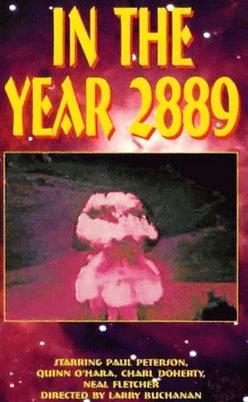
In the Year 2889 is a 1969 American made-for-television horror science fiction film from American International Pictures about the aftermath of a future nuclear war. The film stars Paul Petersen, Quinn O'Hara, Charla Doherty, Neil Fletcher and Hugh Feagin. AIP commissioned low-budget cult film auteur Larry Buchanan to produce and direct this film as a color remake of Roger Corman's 1956 film Day the World Ended.

Beast from Haunted Cave is a 1959 horror/heist film directed by Monte Hellman and starring Michael Forest, Frank Wolff and Richard Sinatra. It was produced by Gene Corman, Roger Corman's brother. Filmed in South Dakota at the same time as Ski Troop Attack, it tells the story of bank robbers fleeing in the snow who run afoul of a giant spider-like monster that feeds on humans. The film was released as a double feature with The Wasp Woman (1959).

Charles Byron Griffith was an American screenwriter, actor, and film director. He was the son of Donna Dameral, radio star of Myrt and Marge, along with Charles' grandmother, Myrtle Vail, and was best known for writing Roger Corman productions such as A Bucket of Blood (1959), The Little Shop of Horrors (1960), and Death Race 2000 (1975).

Day the World Ended is a 1955 independently made black-and-white post-apocalyptic science fiction film, produced and directed by Roger Corman, that stars Richard Denning, Lori Nelson, Adele Jergens, Paul Birch (actor) and Mike Connors. Chet Huntley of NBC, later of The Huntley-Brinkley Report, served as the film's narrator. It was released by American Releasing Corporation as a double feature with The Phantom from 10,000 Leagues.

Gunslinger is a 1956 American Western film directed by Roger Corman and starring John Ireland, Beverly Garland and Allison Hayes. The screenplay was written by Mark Hanna and Charles B. Griffith.
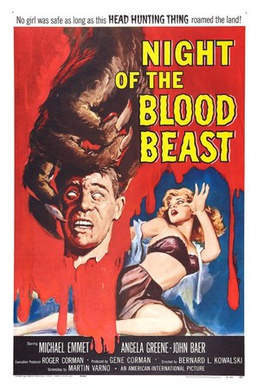
Night of the Blood Beast is a 1958 American science-fiction horror film about a team of scientists who are stalked by an alien creature, which implants its embryos in an astronaut's body during a space flight. Produced by exploitation filmmaker Roger Corman and his brother Gene, it was one of the first films directed by Bernard L. Kowalski and was written by first-time screenwriter Martin Varno, who was 21 years old. It starred several actors who had regularly worked with Roger Corman, including Michael Emmet, Ed Nelson, Steve Dunlap, Georgianna Carter and Tyler McVey. The film was theatrically released in December 1958 as a double feature with She Gods of Shark Reef.

The She-Creature, or The She Creature, is a 1956 American black-and-white science fiction horror film, released by American International Pictures from a script by Lou Rusoff. It was produced by Alex Gordon, directed by Edward L. Cahn, and stars Chester Morris, Marla English and Tom Conway, and casting Frieda Inescort and El Brendel in smaller roles. The producers hired Marla English because they thought she bore a strong resemblance to Elizabeth Taylor.
Alex Gordon was a British film producer and screenwriter.
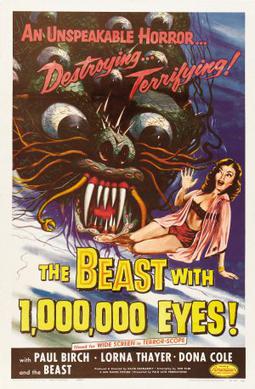
The Beast with a Million Eyes is a 1955 independently made American black-and-white science fiction film, produced and directed by David Kramarsky, that stars Paul Birch, Lorna Thayer, and Dona Cole. Some film sources have said that the film was co-directed by Lou Place. The film was co-produced by Roger Corman and Samuel Z. Arkoff. and was released by American Releasing Corporation, which later became American International Pictures.

Apache Woman is a 1955 American Western directed by Roger Corman and starring Lloyd Bridges. It was Corman's second film as director, following Five Guns West. It was one of four Westerns he made for American International Pictures, the other being Five Guns West, The Oklahoma Woman (1955) and Gunslinger (1956). Corman says Apache Woman and Oklahoma Woman were from ideas by AIP whereas the others were his ideas. This was the first film from Golden State Productions, a company headed by Alex Gordon.

The Oklahoma Woman is a 1956 American Western film directed by Roger Corman.

Naked Paradise is a 1957 drama film directed by Roger Corman. It stars Richard Denning and Beverly Garland.
Lou Rusoff was a Canadian-born screenwriter and producer best known for his work with American International Pictures.

Paul Blaisdell was an American painter, sculptor and visual effects creator, best remembered for his work in science fiction and horror B movies of the 1950s.


















